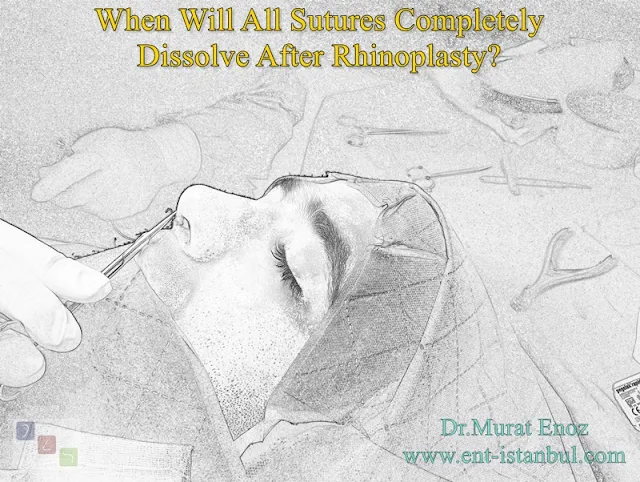The Time For Rhinoplasty Stitches To Dissolve
During the rhinoplasty operation, different stitche materials can be used. Generally, in order to prevent suture reactions in the long term, surgical suture materials that can be melted by the body, that is, self-melting, and surgical tongue materials that can dissolve in the short term are frequently used. In open technique rhinoplasty operations, in some clinics, non-melting aesthetic surgical suture materials that can be used to remove the incision site in the columella one week later; Some surgeons sew this area and the incision under the wings of the nose with suture materials that can dissolve within a few weeks. Generally, I avoid using permanent suture materials that do not dissolve in the body during rhinoplasty operation. The link I posted about foreign body reaction due to permanent suture materials in the nose >> Foreign Body Reactions Due to Non-Absorbable Suture Materials and Skin Fistula After Rhinoplasty Operation
I recommend applying antibiotic skin pomade for a few weeks on the 5/0 rapid vicryl suture material, which we usually use for the incision site on the columella. I prefer PDS and Vicryl suture materials that can dissolve in a longer time for the nasal septum suture in the nose and the fixation of cartilage grafts under the nasal skin.
Time for stitches to dissolve completely
In general, after a period of 6 months, all suture materials used in the nose melt and disappear. It is not possible to take the suture materials used under the skin. Rarely, suture materials thrown into the nasal septum can sometimes melt out of the nose. With the help of a simple scissors, these suture materials can be shortened, but do not try to pull these stitches out with your finger without consulting your doctor, you may cause bleeding and tissue damage.
Permanent stitch reaction
After undergoing nose aesthetic surgery, some individuals may experience a condition known as a permanent stitch reaction. This refers to an adverse reaction to the stitches used during the surgical procedure, leading to persistent symptoms and discomfort. While nose aesthetic surgery, also known as rhinoplasty, is generally safe and effective, complications can occasionally occur, and a permanent stitch reaction is one such potential complication.
During rhinoplasty, stitches are typically used to close incisions made during the procedure. These stitches are meant to hold the tissues together while they heal. In most cases, the body eventually absorbs these stitches, and they do not cause any long-term issues. However, in rare instances, an individual may develop an abnormal immune response to the stitches, leading to a permanent stitch reaction.
The exact cause of a permanent stitch reaction is not fully understood. It may be related to an individual's unique immune system response or an allergic reaction to the materials used in the stitches. Certain factors may increase the risk of developing this reaction, such as a history of allergies, previous surgeries, or certain autoimmune conditions.
Symptoms of a permanent stitch reaction after nose aesthetic surgery can vary from person to person. Common symptoms may include persistent redness, swelling, pain, and discomfort at the site of the stitches. Some individuals may experience itching, a feeling of tightness, or even the formation of small bumps or nodules. These symptoms may persist for an extended period, well beyond the normal healing time after surgery.
If a person suspects they are experiencing a permanent stitch reaction, it is important to consult with their surgeon or a qualified medical professional. The healthcare provider will evaluate the symptoms and may perform tests to determine the underlying cause. This may involve a physical examination, imaging studies, or even a biopsy of the affected area.
Treatment options for a permanent stitch reaction can vary depending on the severity of the symptoms. In mild cases, conservative management may be recommended, such as the application of topical medications or the use of cold compresses to reduce swelling. In more severe cases, surgical intervention may be necessary to remove the stitches or address any complications that have arisen as a result of the reaction.
Prevention of a permanent stitch reaction is challenging since it is difficult to predict who will develop this complication. However, individuals can reduce the risk by thoroughly discussing their medical history and any known allergies with their surgeon before the procedure. Additionally, it is essential to choose a skilled and experienced surgeon who follows proper surgical techniques and uses high-quality materials.
It's important to note that a permanent stitch reaction is a relatively rare complication of nose aesthetic surgery. Most individuals who undergo rhinoplasty experience a smooth recovery without any long-term issues. However, if any concerns or complications arise after surgery, it is crucial to seek medical attention promptly to ensure appropriate evaluation and management.
Murat Enoz, MD, Otorhinolaryngology, Head and Neck Surgeon - ENT Doctor in Istanbul
Private Office:
Address: İncirli Cad. No:41, Kat:4 (Dilek Patisserie Building), Postal code: 34147, Bakırköy - İstanbul
Appointment Phone: +90 212 561 00 52
Appointment Phone: +90 212 561 00 52
Fax: +90 212 542 74 47



Comments
Post a Comment